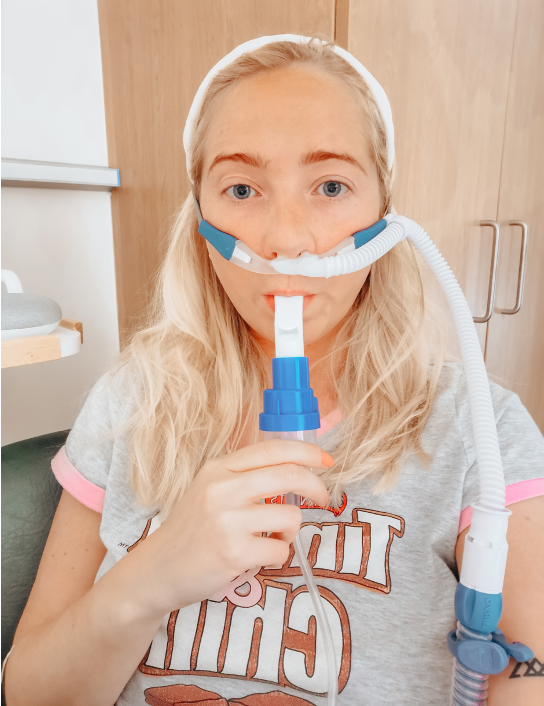How Breathwork Can Help Cystic Fibrosis
Deprived of a Beneficial Therapy?
Although I’ve been in and out of hospitals since my diagnosis of Cystic Fibrosis at 9 years of age, I have never had a CF specialist of any kind teach me the basics on how to breathe correctly or optimally. This sounds a bit bizarre to me, should this not be one of the first things we get a lesson in? We are taught how to use our nebulisers and how to take our inhalers and home IVs. So surely we should be taught how to use our lungs, airways and diaphragm in the most beneficial way? Especially considering the benefits this has for the average person without respiratory issues -as you will learn below.
Our lungs are free, we already have them, so there is no extra cost to our healthcare system. There is also no issue of any unwanted chemicals, toxins or side effects by engaging in breathwork to improve our breathing, unlike that of many medications.
Or am I being ignorant? Is this not part of our respiratory physiotherapy because so many of us struggle to breathe without coughing or loosing our breath? Am I ‘privileged’ with a milder struggle with CF to believe that many of us could manage this type of therapy and in fact could benefit from it much more than the average person?
The Time is Now
Let’s face it, thanks to multiple genetic therapy drugs that are now available for us CFers, the disease is changing. So many of us that are eligible to take these genetic modulators are experiencing less annual hospital admissions, less disease progression, less fatigue, less coughing and breathlessness, living more independent lives and so many females with the disease are even falling pregnant without really trying to, (something that was completely unheard of in CF patients until now!).
Perhaps the time couldn’t be better? Now is the time to actively explore this idea as I am in the middle of my Breathwork Coaching training -don’t steal my idea!! LOL!

Since beginning my training, I have learned so many mind-blowing facts about breathing that I feel compelled to share with the CF community, so sit tight while I dive in…
The Facts
- Similar to aerobic exercise, breathwork improves your heart function and strengthens your muscles. But most importantly, -for the CF community, breathing exercises can improve your lung capacity!
- Did you know, it is more beneficial for you to breathe through your nose, rather than your mouth on a daily basis? This is because the nose filters and humidifies the air before it goes into your lungs. The hairs in our nostrils catch any unwanted germs and prevent them from being inhaled into the lungs. -A great tip for anyone attending their CF hospital any time soon. However, when working out, it can be more beneficial to breathe through the mouth.
- The average person only uses 1 litre of their 6-7 litre lung capacity. So many of us breathe far too shallowly, not engaging in belly breathing, also known as diaphragmatic breathing. Instead, we only inhale as far as our chest. It is essential that we engage our diaphragm while breathing. If we don’t, overtime this primary breathing muscle will become stiff and weak. So the sooner we correct this the better!
- It’s also worth noting, if you live in a state of chronic stress, there is a good chance that you experience constriction in your diaphragm. The diaphragm rests under your ribcage and contracts and flattens out to fill the lungs with air. As you exhale, it relaxes and expands upward. When we are breathing at a restful rate, it handles most of the work. But when we are highly stressed, our breathing becomes shallow and most of the work is done by the set of secondary breathing muscles which consist of the neck, back and the upper chest, while the diaphragm does very little. This is why these areas become stiff, tense and sore when you are stressed.
Over time, this causes stale air to build up, leaving less room for the diaphragm to contract and bring in fresh oxygen. This leads to lower oxygen levels, and less reserve for exercise and activity. - If practiced regularly, breathing exercises can help rid the lungs of accumulated stale air, increase your blood oxygen levels, improve your lung capacity and get the diaphragm to return to its job of helping you breathe optimally.
Let’s Get to Work
Okay so I imagine after digesting some of those interesting facts and benefits, that you now want to put it all into action!
Here are a couple of simple breathing exercises that you can try out. Everyone will find that certain exercises suit them better than others which is completely fine!
It’s also worth noting that the topic we’re discussing here is called BreathWORK, -meaning it really is work. The first couple of attempts can feel tricky and uncomfortable so it’s best to only try them out when you are feeling up for it, i.e. not if you are experiencing shortness of breath, chest pain, light-headedness, hemoptysis or an infection. You are the best judge of your body so listen carefully to it.
If you are finding the exercises a bit tricky to figure out, you can type the different exercises into Youtube for some helpful tutorials.
Pursed Lip Breathing
This exercise reduces the number of breaths you take and keeps your airways open longer. It will allow more air to flow in and out of your lungs so you can be more physically active.
To practice this exercise, inhale through your nose and exhale at least twice as long through your mouth, with pursed lips.
Belly Breathing (Diaphragmatic Breathing)
As with the previous exercise, start by inhaling via the nose. Pay attention to how your belly fills up with air. You can place a hand on your stomach to help guide you with this. Now focus on your belly rising and falling. Exhale through your mouth at least two times as long as your inhale.
Ensure to relax your neck and shoulders as you engage in this exercise to keep the focus on retraining your diaphragm.
Bending forward at the waist may make breathing easier as it can reduce shortness of breath. It helps the diaphragm to move easier. Just ensure to hold on to a countertop or chair if you’re standing to prevent falling or losing your balance.
Ideally, you should practice both exercises for about 5 to 10 minutes every day.
*****
Let’s Connect!
I hope you find these exercises helpful. Please feel free to reach out to me via my Instagram account @aoife.p.r or website www.aoifepr.com if you have any questions or comments, or your own tips for breathing techniques!
I believe that there is so much more that we can all learn from one another through collaboration.
Aoife P. R.






